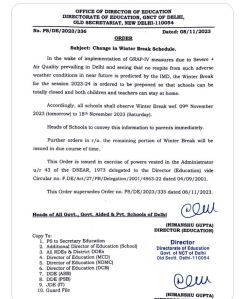Delhi Air Emergency Leads To Premature Winter Break In Schools, Classes To Remain Shut From Nov 9
As the Air Quality Index (AQI) of the national capital dips to ‘hazardous’ category, Delhi Directorate of Education (DoE) on Wednesday announced the premature winter break for all schools commencing from November 9 to 19, 2023.
Read More: ‘Congress President Controlled By Remote,’ Says PM Modi In MP’s Damoh
According to the order issued by the DoE dated November 8, 2023, in the wake of implementation of GRAP-IV measures due to Severe + Air Quality prevailing in Delhi and seeing that no respite from such adverse weather conditions in near future is predicted by the IMD, the Winter Break for the session 2023-24 is ordered to be preponed so that schools can be totally closed and both children and teachers can stay at home.
“Accordingly, all schools shall observe Winter Break with effect from November 9, 2023 to November 18, 2023,” it stated.

However, as Delhi and the National Capital Region (NCR) grapple with severe air pollution, a thick, toxic haze, commonly referred to as 'smog,' continued to shroud the region. According to data from the System of Air Quality and Weather Forecasting and Research (SAFAR), the overall air quality index (AQI) in the national capital stood at 395 on November 8, at 9:30 a.m. This marked a concerning level of pollution.
Delhi government announces early winter break in schools from 9th to 18th November amid severe air pollution in the national capital pic.twitter.com/g9TDdHouot
— ANI (@ANI) November 8, 2023
Numerous areas in Delhi reported AQI in the 'severe category,' as per the Central Pollution Control Board (CPCB). Specifically, CPCB data indicated that AQI was at 434 in RK Puram, 415 in ITO, 439 in Patparganj, and 451 in Rohini. The severity of air pollution in these areas was highly distressing.
Alarming statistics from aqicn.org revealed that the air quality in Delhi's Anand Vihar was particularly dire, with AQI levels approaching an astounding 1000.
Key highlights of the air quality situation include:
According to aqicn.org data at 10:30 a.m., Anand Vihar recorded the worst air quality with an AQI of 999.
Other areas in the national capital, such as Jahangirpuri, Wazirpur, Bawana, and Mundka, reported AQI levels above 700, signifying that residents were breathing 'hazardous' air. Jahangirpuri recorded an AQI of 775, Wazirpur registered AQI at 776, Bawana reported an AQI of 754, and Mundka documented an AQI of 792.
The dire air quality situation led to the Commission for Air Quality Management (CAQM) invoking Stage IV of the Graded Response Action Plan (GRAP) in the entire National Capital Region (NCR). This was done with immediate effect to mitigate further deterioration in air quality.